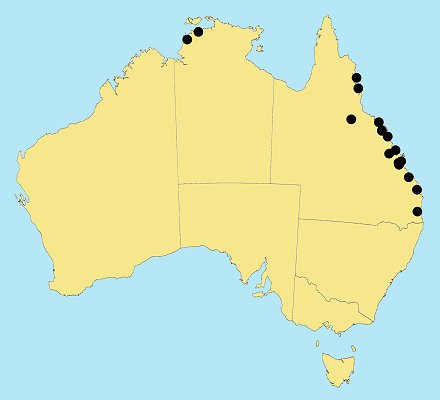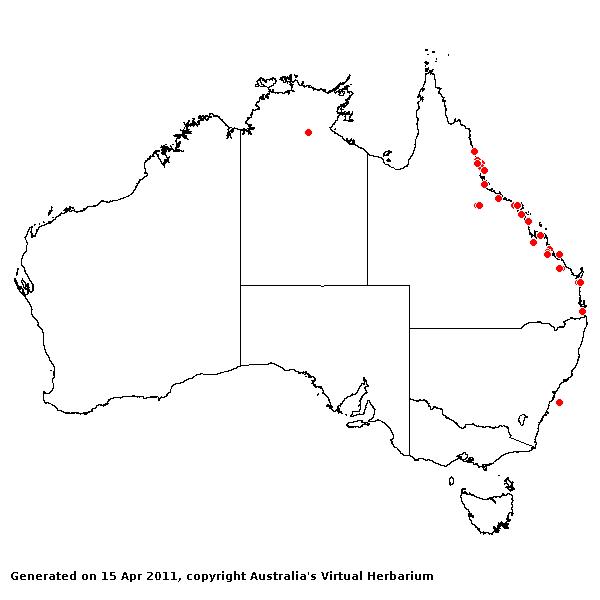Echinochloa dietrichiana P.W.Michael. Telopea 8: 403 (1999).
Classification. (GPWG 2001) : Subfamily Panicoideae. Paniceae.
Type of Basionym or Protologue Information: Australia: Queensland: Cook District: South Johnstone, 17º33'S, 146º00'E, R.H. Edmonson s.n. (HT: BRI-079502).
Key references (books and floras): [2002] D.Sharp & B.K.Simon, AusGrass, Grasses of Australia.
Habit. Annual. Culms erect or decumbent, 150 cm tall (-200), 5–8 -noded. Mid-culm nodes glabrous. Ligule a fringe of hairs or absent, 1 mm long. Leaf-blades 20–30 cm long, -10 mm wide. Leaf-blade surface smooth.
Inflorescence. Inflorescence compound, a panicle of racemes. Racemes 3.5–5 cm long. Central inflorescence axis 10–27 cm long.
Spikelets. Spikelets pedicelled. Fertile spikelets 2-flowered, the lower floret barren (rarely male), the upper fertile, comprising 1 basal sterile florets, comprising 1 fertile floret(s), without rachilla extension, ovate, dorsally compressed, 3 mm long.
Glumes. Glumes dissimilar. Lower glume ovate, membranous, without keels, 5 -nerved. Lower glume surface indumented. Upper glume ovate, 3 mm long, membranous, without keels, 5 -nerved. Upper glume surface indumented. Florets. Basal sterile florets 1, male (rarely) or barren, with palea. Lemma of lower sterile floret 100 % of length of spikelet, membranous, 5 -nerved, awned.
Fertile lemma 3 mm long, without keel, 5 -nerved. Lemma apex mucronate. Grain 1.6–1.8 mm long.
Continental Distribution: Australasia.
Australian Distribution: Northern Territory, Queensland.
Northern Territory: Darwin & Gulf. Queensland: Cook, Moreton, North Kennedy, Port Curtis, South Kennedy, Wide Bay.
Notes. The epithet commemorates Amalie Dietrich (18221–1891), a remarkably skilful collector in the 1860s for the Hamburg merchants J.C. Godeffry and Son.
The current extent and conservation status of this species are unknown but it would appear to be quite vulnerable to competition for exotic perennial grasses. It is likely to have been overlooked by recent plant collectors due to its superficial resemblance to other species of Echinochloa, both native and exotic.
E. dietrichiana has been confused with two other annual taxa, namely, the native E. telmatophila and E. crus-galli ssp. hispidula, an important weed of rice especially in the Indian subcontinent, south-east Asia, China and Japan.
A non-weedy native species occurring in seasonally flooded areas in coastal Queensland and N.T., sometimes close to areas subject to tidal influence.


